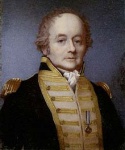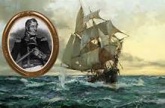As a result of my activities at Gloucester and the British Marines taking part in the Tall Ships regatta, I decided to look into the development of this arm of the Navy.
With the help of this book and the Internet I managed to piece together this little synopsis.
The Origins of the Royal Marines.
The 'first official' unit of English naval infantry, originally called the Duke of York and Albany's Maritime Regiment of Foot and soon becoming known as the Admiral's Regiment, was formed on 28 October 1664, with an initial strength of 1,200 infantrymen recruited from the Trained Bands of London as part of the mobilization for the Second Anglo-Dutch War.
James (later King James VII & II), the Duke of York and Albany, Lord High Admiral and brother of King Charles II, was Captain-General of the Artillery Company, now the Honourable Artillery Company, the unit that trained the Trained Bands.
It was the fifth European Marine unit formed, being preceded by the Spain's Infantería de Marina (1537), the Fanti da Mar of the Republic of Venice (1550), the Portuguese Marine Corps (1610) and France's Troupes de marine (1622). It consisted of six 200-man companies and was initially commanded by Colonel Sir William Killigrew with Sir Charles Lyttleton as lieutenant-colonel. Killigrew had commanded an English regiment in Dutch service, and many of the regiment's initial complement of officers had served there as well.
The Holland Regiment (later The Buffs) was also raised to serve at sea and both of these "Naval" regiments were paid for by the Treasurer of the Navy by Order of Council of 11 July 1665. John Churchill, later the 1st Duke of Marlborough, was a famous member of this regiment. A Company of Foot Guards served as Marines to augment the Marines of the Admiral's Regiment during the key sea battle the Battle of Solebay in 1672. The regiment was disbanded in 1689 shortly after James II was deposed in the Glorious Revolution.
Portrait of a Maritime officer, by William Dobson, 17th century
Prince of Denmark's Regiment.
Two more marine regiments of the army were raised in 1690. They were the Earl of Pembroke's and Torrington's, later Lord Berkeley's. These two regiments participated in an opposed landing during the Williamite War in Ireland at Cork, Ireland on 21 September 1690 under the command of John Churchill, now the Duke of Marlborough.
John Churchill.
In 1698, the Marine establishment was reformed: the two existing regiments were reformed into a single one under the command of Thomas Brudenell, while the foot regiments of William Seymour, Edward Dutton Colt, and Harry Mordaunt were converted into Marine regiments. These regiments were disbanded in 1699.
Gibraltar 1702.
William Seymour.
In 1702, six Regiments of Marines and six Sea Service Regiments of Foot were formed for the War of the Spanish Succession. When on land, the Marines were commanded by Brigadier-General William Seymour, formerly of the 4th Foot. The most historic achievement of these Marines was the capture of the mole during the assault on Gibraltar (sailors of the Royal Navy captured the Rock itself) and the subsequent defence of the fortress alongside the Dutch Marines in 1704.
In 1713, after the Treaty of Utrecht, three of these Regiments were transferred to the Line, where they became the 30th through the 32nd Foot.
Eighteenth Century.
Six Marine Regiments (1st to 6th Marines, 44th to 49th Foot) were raised on 17–22 November 1739 for the War of Jenkins' Ear, with four more being raised later. One large Marine Regiment (Spotswood's Regiment, later Gooch's American Regiment) was formed of American colonists and served alongside British Marines at the Battle of Cartagena de Indias, Colombia and Guantánamo Bay, Cuba in the War of Jenkins' Ear (1741).
Lawrence Washington.
Among its officers was Lawrence Washington, the half-brother of George Washington. In 1747, the remaining regiments were transferred to the Admiralty and then disbanded in 1748. Many of the disbanded men were offered transportation to Nova Scotia and helped form the city of Halifax, Nova Scotia.
On 5 April 1755, His Majesty's Marine Forces, fifty Companies in three Divisions, headquartered at Portsmouth, Chatham and Plymouth, were formed by Order of Council under Admiralty control. Initially, all field officers were Royal Navy officers as the Royal Navy felt that the ranks of Marine field officers were largely honorary. This meant that the farthest a Marine officer could advance was to lieutenant colonel. It was not until 1771 that the first Marine was promoted to colonel. This situation persisted well into the 1800s. During the rest of the 18th century, they served in numerous landings all over the world, the most famous being the landing at Bellisle on the Brittany coast in 1761.
They also served in the American War of Independence. A company of Marines under the command of Major John Pitcairn broke the rebel resistance in the Battle of Breed's (Bunker) Hill and took possession of the enemy redoubt.
These Marines also often took to the ship's boats to repel attackers in small boats when RN ships were becalmed on close blockade. Captain James Cook took with him four marines on the day he was killed in Hawaii, 14 February 1779, Corporal James Thomas, Private Theophilus Hinks, Private Thomas Fatchett and Private John Allen.
New South Wales.
From May 1787, a detachment of four companies of marines, under Major Robert Ross, accompanied the First Fleet to protect a new colony at Botany Bay (New South Wales).
Major Robert Ross.
Due to an administrative error the Fleet left Portsmouth without its main supply of ammunition, cartridge paper and tools to repair their flintlocks. The omission was noted early during the voyage and, in July 1787, a request was sent back to the British Home Office from Santa Cruz that the missing supplies be sent out in William Bligh's ship HMS Bounty. Ten thousand rounds of ammunition were also obtained when the Fleet called into Rio de Janeiro en route to Botany Bay. However, despite the Home Office receiving the request, the full resupply was never sent and consequently, after 12 months, the marines ended up in difficult circumstances.
The First Fleet detachment had a strength of 212 including 160 privates. This relatively small force was arranged on the advice of Joseph Banks who advised the British government that local Aborigines were few and retiring. On arrival in New South Wales in January 1788 the Governor of the new colony, naval Captain Arthur Phillip, found that the natives were vastly more numerous than expected and also that they soon started resisting the settlers. Within 12 months, natives killed 5 or 6 First Fleeters and wounded others. Finally, in October 1788, the marines were tasked to expand the initial settlement at Sydney Cove to commence farming more fertile land at Parramatta.
One author has claimed that the Marines deliberately spread smallpox among Australia's indigenous population in order to reduce its military effectiveness, but this is not corroborated by contemporaneous records of the settlement and most researchers attribute the indigenous smallpox outbreak to other causes.
Nineteenth century.
In 1802, largely at the instigation of Admiral John Jervis, 1st Earl of St Vincent, they were titled the Royal Marines by King George III.
The Royal Marine Artillery (RMA) was formed as an establishment within the British Royal Marines in 1804 to man the artillery in bomb vessels. This had been done by the Royal Regiment of Artillery, but a lawsuit by a Royal Artillery officer resulted in a court decision that army officers were not subject to naval orders. As their coats were the blue of the Royal Regiment of Artillery, this group was nicknamed the "Blue Marines" and the infantry element, who wore the scarlet coats of the British infantry, became known as the "Red Marines", often given the derogatory nickname "Lobsters" by sailors.
Major General John Tupper His Majesty's Marine Forces.
French Revolutionary and Napoleonic Wars.
During the Napoleonic Wars the Royal Marines participated in every notable naval battle on board the Royal Navy's ships and also took part in multiple amphibious actions. Marines had a dual function aboard ships of the Royal Navy in this period; routinely, they ensured the security of the ship's officers and supported their maintenance of discipline in the ship's crew, and in battle, they engaged the enemy's crews, whether firing from positions on their own ship, or fighting in boarding actions.
The number of marines on board Royal Naval ships depended on the size of the ship and was generally kept at a ratio of one marine per ship gun, plus officers. For example: a First Rate Ship of the Line contained 104 marines while a 28 gun Frigate had 29. Between 1807 and 1814, the total marine establishment number was 31,400 men. Manpower (recruitment and retention) problems saw regular infantry units from the British Army being used as shipboard replacements on numerous occasions. One result of the Royal Navy's dominance of the seas in Europe, and the blockading of the French Navy's ports, was that manpower constraints became less of an issue at the end of the Napoleonic Wars. From 1812, such maritime supremacy meant the Mediterranean and Channel Fleets were assigned additional marines for use 'in destroying signal communications and other petty harassing modes of warfare'.
1st Corps of Colonial Marines.
In the Caribbean theatre volunteers from freed French slaves on Marie-Galante were used to form the 1st Corps of Colonial Marines. These men bolstered the ranks, helping the British to hold the island until reinforcements arrived. This practice was repeated during the War of 1812, where escaped American slaves were formed into the 2nd Corps of Colonial Marines. These men were commanded by Royal Marines officers and fought alongside their regular Royal Marines counterparts at the Battle of Bladensburg in August 1814.
Battle of Bladensburg.
During the battle a detachment of Royal Marine Artillery commanded by Lieutenant John Lawrence deployed Congreve rockets resulting in the rout of the US militiamen.
Tracks of Congreve Rockets at Bladensburg.
The Royal Marines battalion and the 21st Regiment of Foot also took part in the Burning of Washington later that day.
Also present on shore during the Chesapeake campaign was a composite battalion of Marines, formed from ships' Marine detachments, frequently led by Captain John Robyns. A smaller composite battalion of about 100 men (23 officers,] two of whom (John Wilson 1787-1850 and John Alexander Phillips 1790-1865) were Trafalgar veterans, and 80 other ranks) also took part in the Battle of New Orleans, under the command of Brevet Major Thomas Adair, in January 1815. The only British success at New Orleans was an attack on the west bank of the Mississippi River by a 700-man force, consisting of the 100 Royal Marines, 100 sailors under Captain Rowland Money, and 3 companies of the 85th Foot
Throughout the war Royal Marines units raided up and down the east coast of America including up the Penobscot River and in the Chesapeake Bay. They later helped capture Fort Bowyer in Mobile Bay in what was the last action of the war.
In 1815 Royal Marines of HMs Belleraphon helped escort the Emperor Napoleon to his final exile on St.Helena.
Rob.







 Reply With Quote
Reply With Quote






Bookmarks